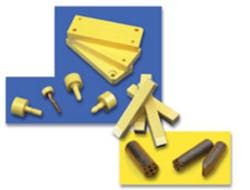The first ESD-safe materials developed were polymers in a number of formulations. One formulation uses a small amount of a carbon-black conducting additive to create a weakly conducting network in a nonconducting polymer matrix. Another approach coats the polymer with a weakly conductive surface layer like vanadium pentoxide. More recently, intrinsically conducting polymers have been marketed.
While they have many useful attributes, polymers do not resist abrasion, have a stiffness rating usually several orders of magnitude less than the stiffness of metals or ceramics, and tend to creep under load. These drawbacks make them unsuitable for precision tooling and operations where high volumes of parts are being processed. To address these limitations, a new class of materials—ESD-safe ceramics—has been developed.
What Are ESD-Safe Ceramics?
ESD-safe ceramics possess the mechanical properties of ceramics and electrical properties tailored to dissipate charge. Abrasion resistance is provided by their high hardness, typically 10 gigapascals (Gpa) or more Vickers hardness vs. 6 GPa for tool steel. The stiffness rating of ceramics usually is higher than steels, and creep is undetectable up to temperatures >1,000oF.
Table 1 (see below) presents a comparison of the properties of ESD-safe ceramics to those of metals and ESD-safe polymers. The three classes of materials commonly are encountered in tooling for electronic component production and testing.
Table 1. Choices of Tooling Materials for Manufacturing Static-Sensitive Components
ESD-safe ceramics are formed by making a composite of an insulating structural ceramic, such as zirconium oxide, with a conductive metal oxide. A composite is needed because the materials with the strength and toughness to be considered for structural purposes are ceramic insulators or metallic conductors.
The amount of the conducting phases is adjusted to make the resistivity 106 to 109 W-cm in the dissipative range. The grain size of the composite is in the range 0.5 µm to 5 µm, which is much smaller than even the smallest electronic parts presently handled. For practical purposes, the material appears as an electrically uniform substance.
Application Areas in Electronic Test
In electronic test applications, ESD-safe ceramics are used mainly in areas where abrasion resistance and stiffness are needed. The first application we know of was ceramic tips for tweezers in manual handling of components. Here ESD-safe ceramics replaced metal tweezer tips, reducing the possibility that ESD-induced damage occurred during manual handling of parts. Use of ESD-safe polymers was not possible since they lack the stiffness needed to get a good grip on parts when using a fine tip.
A logical extension of this application is the use of ESD-safe ceramics on the tips of pick-and-place tools. Such tools commonly use ceramic tips to pick up parts because the ceramics provide wear resistance.
The usual ceramics are insulators, so there is a risk that the part being picked up will acquire a static charge via triboelectric effects or moving through an electric field gradient. This charge then may be catastrophically drained when the part next contacts a conductor, such as a test socket. If the tip is made of ESD-safe ceramics, then charges are safely dissipated, and the problem does not arise.
Another application becoming of interest is the substitution of ESD-safe ceramics for ESD-safe polymers such as Vespel®-21 in IC test sockets. After a large number of parts have been tested, abrasion causes polymers to shed particles. These particles interfere with the test contacts, leading to occasional spurious rejections of good parts.
The cure is to substitute ESD-safe ceramics for the polymers. The superior wear resistance of the ESD-safe ceramics reduces particle generation and raises productivity by decreasing downtime and false part rejections.
Specifying ESD-Safe Ceramic Parts
In many circumstances, engineers can consult the manufacturer of the test equipment for help in selecting ESD-safe ceramic tooling. However, ESD-safe ceramics are sufficiently new so there may be times when adventurous souls will wish to fabricate their own parts. For example, custom-built test equipment may require upgrading for ESD safety.
Watch for some problems. The first is a generic one associated with ceramics: the best designs for ceramic parts almost always are different from their counterparts in plastic or metal. Blindly requesting a ceramic copy of an existing part will very likely result in a high-cost, poorly performing part.
A second problem is the brittleness of ceramics. In our experience, most brittleness issues can be circumvented by eliminating sharp internal corners. Once this is done, the inherent strength of the ceramic, which usually is at least as good as most commonly used metals and much better than plastics, will allow the design to perform.
Another problem is machining. Ceramics can be formed in the unfired state by many methods including injection molding. But in most cases, machining after firing is required. Certain machining operations, notably milling and thread cutting, can be done very easily in metals but hardly at all in fired ceramics.
When developing a design for a part in ceramic, it is critical to consider how the part will be fabricated. For that reason, we strongly advise that you consult the fabricator early in the design process.
About the Authors
Oh-Hun Kwon is the senior research associate responsible for developing ESD-safe ceramics at Saint-Gobain Ceramics & Plastics. He has been associated with the development of ceramic tooling for more than 10 years and holds a Ph.D. from Pennsylvania State University. e-mail: [email protected]
Matthew Simpson is a member of the technical staff at Saint-Gobain Ceramics & Plastics. After getting a degree from Monash University, he has been working for 20 years with ceramic materials. e-mail: [email protected]. Saint-Gobain Ceramics & Plastics, Goddard Rd., Northboro, MA 01532, 508-351-7944
Return to EE Home Page
Published by EE-Evaluation Engineering
All contents © 2003 Nelson Publishing Inc.
No reprint, distribution, or reuse in any medium is permitted
without the express written consent of the publisher.
August 2003

